This easy (and we mean EASY!) homemade French bread recipe is sure to be a hit! Homemade dutch oven bread that's ready in just a few hours - no overnight rise. Crispy crust on the outside and soft, airy bread on the inside! Vegetarian.
WE NEED TO TALK ABOUT THIS BREAD. ⬆⬆⬆ ⬇⬇⬇
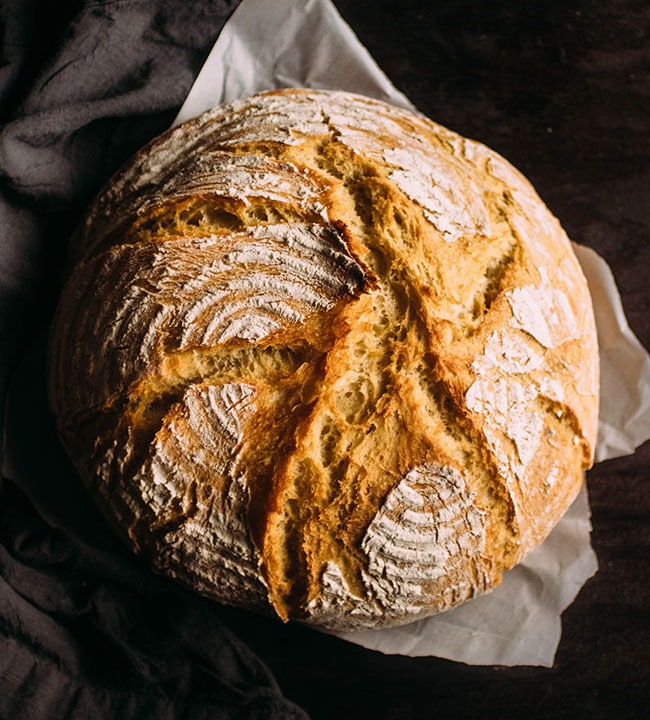
What you need to know about this crusty bread:
- It's ready in under three hours. No overnight rise necessary!
- It's ultra-forgiving. Read through ALL of our recipe notes for best results!
- No Dutch oven? You can still make great bread - check out this post for our best tried-and-true alternatives.
- YOU CAN MAKE THIS BREAD ⬇⬇⬇. I PROMISE.
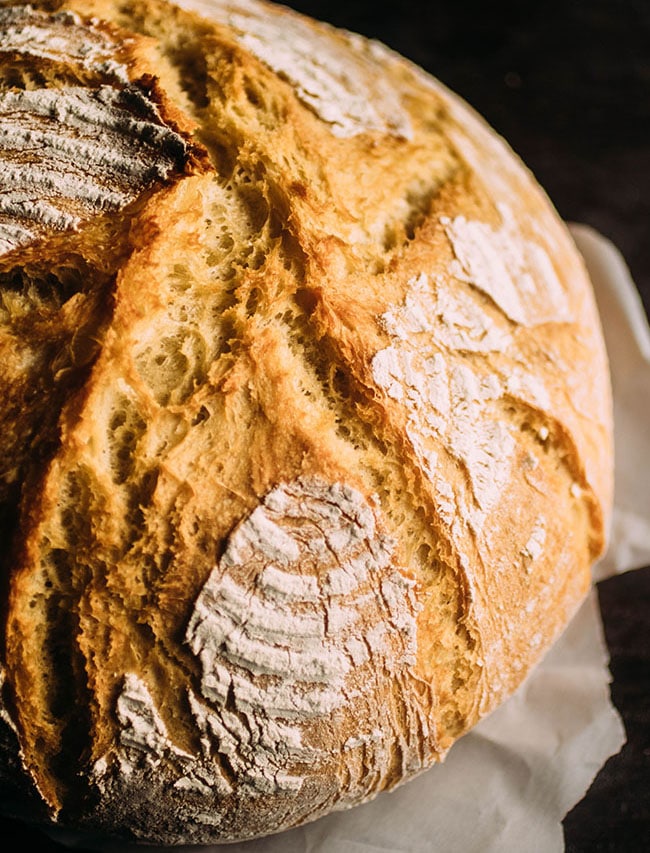
The basic order of operations for this artisan bread:
The instructions may look a little long, but they're all basically just notes on technique - so don't let the number of steps intimidate you!
After a couple of adventures with this bread, you'll be able to throw it together in your sleep.
- Mix the dough (10 minutes) This is a very slack dough (also known as a wet or sticky dough) - it won't form a ball or be immediately elastic like some recipes you might be used to! The dough will be shaggy and somewhat sticky, but it will smooth out as the gluten develops while it rises and again when it's time to shape.
- Let the dough rise (1 hour) Kick back, relax, and let your dough do it's thing!
- Shape the dough (5 minutes) Lightly flour a cutting board, tip the dough out, and gently form it into a round loaf (watch the videos below to see exactly how we do this!)
- Let the dough rise one final time (30 minutes) When your dough is shaped, pop it into a medium-sized bowl or proofing basket to rise for 30 minutes while you preheat the oven.
- Bake (45 minutes) Carefully transfer the bread to your preheated Dutch oven (or use an alternative method!) I like to use a piece of parchment paper to make it easier to lift the bread in and out of the pot. Bake for 30 minutes with the lid on, then remove the lid and bake another 10-15 minutes to help the bread develop more color.
- Let the bread cool, slice, and enjoy!
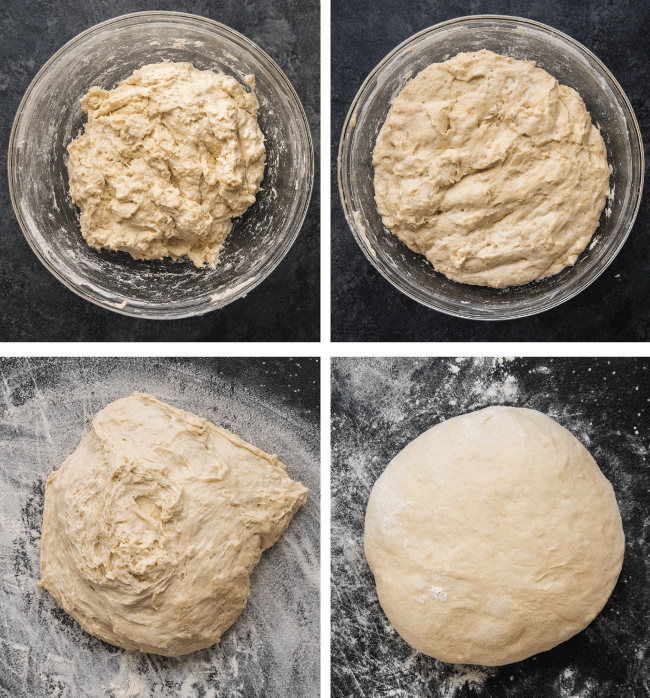
If you're serious about homemade bread, you may enjoy using a proofing basket (it's one of my favorite kitchen tools!) to help the bread keep its shape while it rises. You also end up with beautiful flour rings on the crust! We like to use an 8- to 9-inch proofing basket for a single loaf of bread.
If you don't have a proofing basket, no worries! Just use a medium-sized (8- or 9-inch diameter) mixing bowl to let the bread do its final rise before you bake it. Flour the bowl well to prevent sticking!
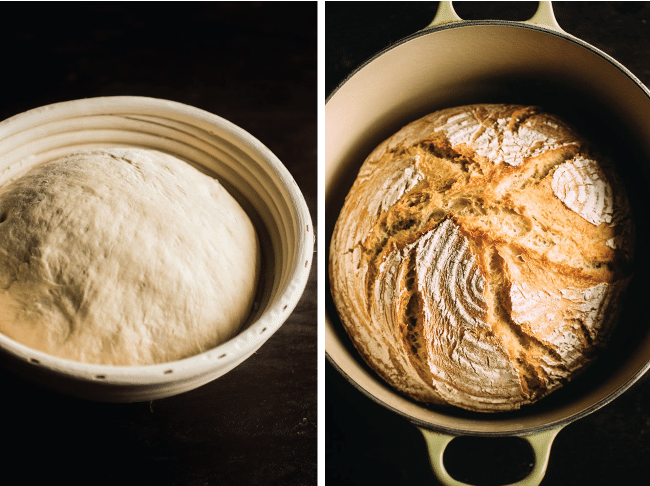
The crackly brown crust here is the result of baking this bread in a Dutch oven. By keeping the lid on while the bread bakes, you create a nice steamy atmosphere inside the pot - and the steam is what gives the bread that crispy, magical crust. (Read more about the importance of steam in bread baking here!)
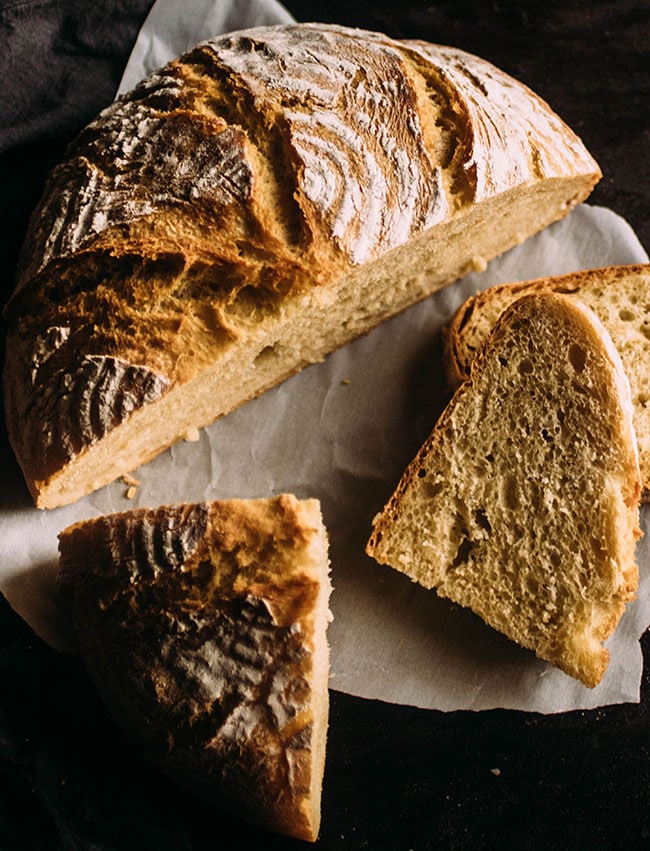
HOMEMADE BREAD FAQ
This section is LONG - but we wanted to cover the most frequent questions we get! Feel free to skip right to the recipe, but please do utilize this section if you run into questions while you're baking. For additional training videos, tips, and recipes, check out Everyday Artisan Bread!
- My dough feels too wet. This is a very slack (wet) dough - the dough should feel quite shaggy and a bit sticky when mixed. This dough should NOT pull away from the sides of a bowl into a smooth, elastic ball like other recipes you may have used. Don't worry - it will become more elastic as gluten develops while the dough rises! If you are still worried about the consistency of the dough, feel free to mix in more flour ¼ cup at a time - especially if you measured your flour by volume (in cups, which can frequently result in using too much or too little flour) rather than by weight with a kitchen scale.
- Related: Please use a kitchen scale! If you already have a scale, please use it. Just set the scale to grams, place an empty bowl or container on top, set the scale to zero, and add your ingredients until it reaches the right weight. If you don't have a scale, you can still make great bread without it - just make sure to follow the notes in the recipe below - but if you plan to bake bread a lot, a scale is definitely worth the investment!
- Can I use rapid rise or instant yeast for this recipe? Yes - just reduce the amount of yeast to 1 ½ teaspoons (about 25% less than we use with Active Dry Yeast).
- How do I stop the bottom of my loaf from burning or overbaking? There are a bunch of ways to adjust if the bottom of your bread is burning! 1. use an oven thermometer to check the true temperature of your oven (I've had ovens that are off by as much as 40 degrees in one direction!) 2. Make sure your oven rack is in the center of your oven (or, if burning occurs while baking in the center of your oven, move your rack one notch farther away from your heat source). 3. Try placing a sheet pan directly underneath your Dutch oven when baking to redistribute some of the heat, or 4. preheating your Dutch oven for half the time. 5. Some testers also have good luck placing a baking steel or pizza stone on the rack directly below the Dutch oven, again to redistribute some of the heat. 6. Make sure to use a piece of parchment paper to lift the bread in and out of your Dutch oven. 7. Dust the bottom of your loaf with a thin layer of cornmeal before placing it into the Dutch oven to form a barrier between the dough and the hot surface. 8. Try preheating and baking at a slightly lower temperature (between 425 and 450 degrees F) OR preheating at the suggested temperature of 460 and then turning the oven down to 425 degrees F once you put the bread in. Don't worry if it takes a few tries to find your sweet spot - ovens and equipment can vary wildly when it comes to heat distribution, and a big part of bread baking is figuring out your oven's own unique quirks so you can consistently get the results you want!
- Can I double this recipe? Yes - double everything except the yeast in this recipe for best results*. After the first rise, divide the dough in half and form two loaves (our preference) or form one large loaf. If you bake a large loaf, you will likely need to extend the bake time and it may not cook quite as evenly - just keep an eye on it and use your best judgment! (*the converter in the recipe card below may tell you to double the yeast as well, but you really don't need to. We just can't figure out how to turn the converter off *facepalm*)
- Can I halve this recipe for a smaller loaf? Yes! We have a scaled-down version of this recipe (with adjusted measurements and instructions!) in our Small Batch Crusty Bread post.
- How hot should my water be? A good rule of thumb is "warm to the touch." Too-hot water (typically 130-140 degrees F and above) will kill your yeast, but use too-cold water and your yeast will take too long to activate. We typically use water that's between 95 and 110 degrees Fahrenheit for our Active Dry Yeast. You should be able to comfortably hold your hand under water running at about 100 degrees - it should feel warm, but not hot. Use a kitchen thermometer for a precise measurement if you like!
- A note about salt: Every brand of salt will perform a little differently. If you're measuring by volume, using Morton Kosher Salt, 1 ¼ teaspoons is usually plenty. If you're using Diamond Crystal Kosher Salt, you may want to use 1 ½ teaspoons since it's significantly lighter/less salty than other brands. If you're using table salt, you'll typically be fine sticking to 1 ¼ teaspoons, but if you prefer less salt in your food, you can dial it back to 1 teaspoon. We recommend measuring your salt by weight to keep things simple!
- What kind of Dutch oven should I use? We recommend using a 4- to 6-Quart Dutch oven. We have tested our artisan crusty bread recipes in Le Creuset, Lodge, Staub, and Marquette Castings Dutch ovens. All work well! Le Creuset and Staub are generally our favorite brands - they do a great job of controlling and evenly distributing heat, and are especially easy to clean. Lodge and Marquette Castings also work well (though if you're used to a Le Creuset, you may notice some differences) and are perfect if you're looking for a budget-friendly option.
- Can I bake this bread without a Dutch oven? Definitely! Read this post for our favorite Dutch oven alternatives (you likely have most of them in your kitchen already!)
- What kind of flour should I use? After extensive testing, we recommend King Arthur All Purpose Flour or Bob's Red Mill All Purpose Flour. If you have bread flour and would like to use it, you certainly can! But it's not necessary. If you don't have Bob's or King Arthur, use whatever All Purpose Flour you have on hand (but add one of those brands to your list for next time - you'll notice a difference!) The only flour we do NOT recommend is Pillsbury - it was consistently the toughest flour to work with in our testing and always created a dough that tore rather than stretched (which we don't want here!)
- How should I store this bread? Store half-loaves cut-side down on a cutting board on the counter for up to 24 hours (no need to cover!) to keep the crust crispy and the interior moist. Store sliced bread in an airtight container in the freezer for 3-4 months (toast it up as needed!) or in an airtight container on the counter for 3-4 days. Freeze a full loaf by wrapping the bread in plastic wrap and popping into the freezer for 3-4 months, then defrost on the counter for a few hours when you're ready to eat (we prefer to avoid plastic, but haven't found a better alternative for this yet - bee's wrap just doesn't do as good of a job here!)
- Can I make this bread with whole wheat flour? Yes! We recommend substituting no more than 50% whole wheat flour for best results.
- My bread didn't rise, or it doesn't have enough big air pockets. Because this is a quick bread recipe with a short rise time, it will typically be a shorter loaf with a tighter crumb (fewer air pockets) than a sourdough recipe or a yeast bread that rises for 8+ hours. If you'd like bigger air pockets and/or a taller loaf of bread, give the gluten in the dough more time to develop by mixing the dough, covering with plastic wrap or a reusable bowl cover, and letting it rise in the fridge overnight. The next day, bring dough to room temperature on the counter, shape and bake as directed! PS - We have a ton of different baking timelines and tips like this in our course!
- Can I add fruits, flavors, or other mix-ins to this bread? Yes! Check out our Roasted Garlic & Rosemary Crusty Bread or our Easy Crusty Asiago Bread for a few of our favorite flavors. Add fresh or dried herbs, spices, roasted garlic, nuts, or dried fruit to the dough right when you mix it. For anything that may release more moisture - fresh fruit, olives, etc. - we recommend folding it in as you shape the bread. Pull the dough into a large circle, spread an even layer of mix-ins across it, then fold dough into the center as directed and repeat until you've added all of the mix-ins.
- Why did my loaf flatten or not hold its shape? Typically, this happens when we haven't built enough strength into the dough before baking. Because this is a relatively quick bread recipe, we lose out on the strength that builds while gluten networks develop over a long rise - so we build strength into the dough by folding it over on itself many times during shaping. If your loaf isn't as tall as you'd like, first be sure to thoroughly mix the dough so that no dry bits of flour remain. You may also want to knead the dough a few times by hand (you can do this right in the mixing bowl) or let your mixer run an extra minute or two with the dough hook attachment. Next, while the dough does its first rise, you can perform one set of "stretch and folds" at the half hour mark to increase strength. Finally, when shaping the dough, be sure to fold the dough over on itself several times until the dough feels tight and begins to resist your folding. Keep in mind that because this bread is made on a quick timeline, it won't typically rise as high as a hearty sourdough loaf or other bread that has had hours or even days to proof. We cover a ton of techniques to bake taller, more open bread in our online course.
- Why don't you transfer the dough to an oiled bowl during the first rise? We don't find it's necessary to add this extra step with this quick recipe, and we wanted to keep it as simple as possible. We just let the dough rise right in the mixing bowl and then run our hands under cold water to coax the dough out without sticking when it's time to tip the dough onto the cutting board. You can absolutely transfer the mixed dough to a lightly oiled bowl for its first rise if you like! A previous version of this recipe had you add a dusting of flour during this first rise; we omitted this step in later revisions to simplify the instructions.
- What is the hydration of this loaf? If you're familiar with baker's percentages, this bread is about 75% hydration by weight as written.
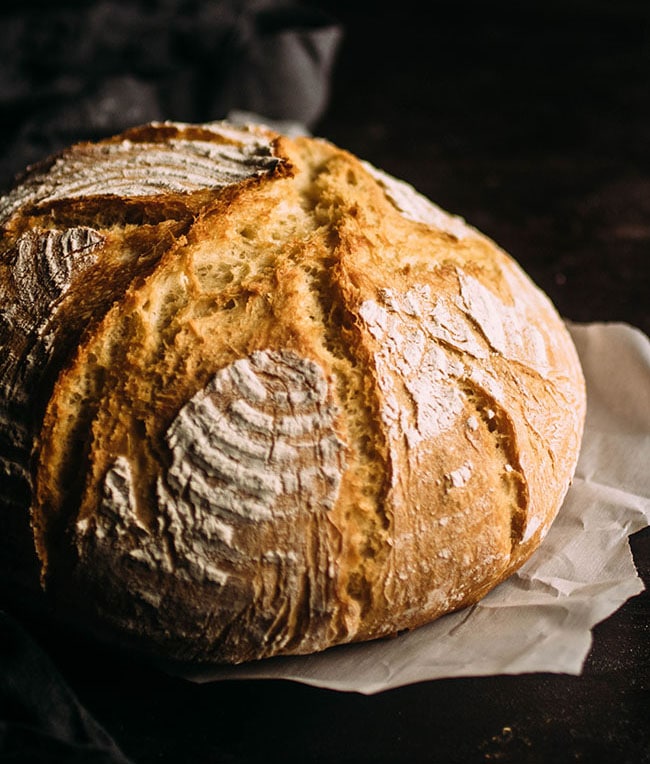
Trouble playing a video? Try disabling your ad blocker.
VIDEO 1: HOW TO MAKE CRUSTY BREAD WITH A STAND MIXER (NO PROOFING BASKET)
VIDEO 2: HOW TO MAKE ARTISAN BREAD BY HAND (WITH PROOFING BASKET)
VIDEO 3: HOW TO SHAPE A LOAF OF BREAD (TUTORIAL)
This video tutorial is an excerpt from our online course, Everyday Artisan Bread!
📖 Recipe
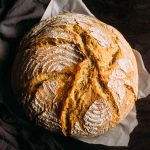
Easy Crusty French Bread
- Prep Time: 15 minutes
- Inactive Time: 1 hour 30 minutes
- Cook Time: 45 mins
- Total Time: 2 hours 30 minutes
- Yield: 1 loaf (about 6-8 servings) 1x
- Category: Bread
- Cuisine: American
- Diet: Vegan
Description
Easy dutch oven bread ready in just a few hours - no overnight rise needed.
Ingredients
- 2 ¼ teaspoons active dry yeast (9 grams)
- 1 teaspoon sugar (4 grams) (use honey if you prefer)
- 1 ¼ cups warm water (300 grams)
- 1 ¼ teaspoons (8 grams) kosher salt
- 2 ½ to 3 ½ cups All-Purpose Flour (400 grams) plus extra for dusting (see recipe notes)
Instructions
MIX THE DOUGH & FIRST RISE (1 HOUR):
- Combine yeast, sugar, and warm water in a large mixing bowl (you can also use a stand mixer fitted with a dough hook).
- Let the yeast proof for about 5 minutes, until the mixture is foamy.
- Add flour to bowl. Mix with a sturdy spatula until the dough starts to come together, then add salt and mix until all ingredients are incorporated. For best results, mix until no dry bits of flour remain. Note: This is a relatively slack (wet) dough, so it may seem a bit shaggy and sticky at this point. Don't worry - it will become more smooth and elastic as we go!
- Cover bowl with a clean tea towel and let rise on the counter for about 1 hour, until dough has doubled in size.
SHAPE THE DOUGH & FINAL RISE (30 MIN):
- When dough has risen, lightly flour a large cutting board.
- Tip the dough out of the bowl and onto the cutting board. DO NOT PUNCH THE DOUGH DOWN - you want to keep all those nice air bubbles intact so you have an airy, delicious loaf of bread. (Note: If the dough is sticking to the bowl a little bit, wet your hand with a bit of cold water and gently separate the dough from the bowl to get it all out).
- Shape the dough into a round loaf: Pull each corner of the dough in towards the center (like you're folding an envelope) and repeat until the dough feels tight and begins to resist your folds. Flip the dough over and pull it into a round loaf. Watch the video(s) above to see exactly how we do this!
- Flour a proofing basket or a medium bowl and place your loaf into it seam-side down. Cover with a tea towel and let rise another 30 minutes or so while you preheat the oven. Note: I like to line my proofing basket or mixing bowl with a clean linen napkin to distribute the flour more evenly and help with cleanup.
HEAT THE OVEN :
- While bread is rising, place an empty dutch oven (with the lid on) in your oven and heat to 460 degrees Fahrenheit.
BAKE!
- When the oven is hot, you're ready to go! Use oven mitts to pull the dutch oven out and remove the lid.
- Lay a piece of parchment paper down on your counter or cutting board (optional - it makes transferring the bread easier!)
- Tip your bread dough gently out of the proofing basket onto the parchment paper. Make sure the seam side is up this time - this is what will create those beautiful cracks on top of the bread!
- VERY CAREFULLY (without burning yourself!) use the sides of the parchment to lift the bread up and place it into the hot Dutch oven.
- Put your oven mitts back on, place the dutch oven lid back on the pot, and slide the whole thing back into your hot oven.
- Cook bread for 30 minutes.
- After 30 minutes, remove the lid from your dutch oven. The bread should be taller, crusty, and very lightly browned. Continue cooking the bread, uncovered, for 10-15 minutes more until the bread has deepened in color and you have a beautiful brown crust.
- When bread is done, use oven mitts to pull the pot out of your oven.
- Use a long spatula or the corners of your parchment paper to lift the bread out of the dutch oven and onto a cooling rack. Let cool for at least 30 minutes before cutting into it.
- Slice, slather with butter, and enjoy!
Notes
How to measure flour: If you have a kitchen scale, please use it! Measuring by weight is MUCH more accurate than measuring by volume (with cups) and will give you more consistent bread. That being said, you can certainly make great bread without a kitchen scale! To measure flour in cups: If you measure flour by dipping your cup straight into the bag or bin and shaking off the excess, plan to use about 2 ½ cups of flour. If you measure by stirring the flour with a spoon or scoop before scooping it into a measuring cup and leveling it off, plan to use about 3 cups of flour. You can always add more flour if you need to - just be aware that this is a relatively slack (wet) dough, so it will be a bit shaggy and sticky at first (but it will smooth out and become more elastic as it rises and again as you shape it!)
Equipment. We recommend a 4- to 6-quart Dutch oven for best results. Le Creuset and Staub are our favorites, but Marquette Castings and Lodge also make solid options that are more budget-friendly. If you don't have a Dutch oven, see this post for alternative baking methods (you can still make great bread without fancy equipment!) Please make sure that your Dutch oven is fitted with a metal (rather than plastic) knob on its lid for best results, and please check the care instructions on your individual equipment before baking. We use this 8.5-inch proofing basket, but an 8- or 9-inch banneton or medium-sized mixing bowl also work well for the final rise.
PLEASE READ THE POST ABOVE FOR OUR COMPLETE FAQs, TIPS, AND ADVICE. We've gotten so many amazing questions from you - we wanted to be sure to answer as many as we can as thoroughly as we can, but if we put our answers here in the recipe it would make it very annoying to print. Please check the FAQ section in the post above if you have a question or run into a problem!
Love this recipe? We'd love to see you in our online course, Everyday Artisan Bread, where we share exclusive training videos, worksheets, and ad-free recipes!
Nutrition
- Serving Size: ⅙ of a loaf
- Calories: 250
- Sugar: 0.9 g
- Sodium: 585.5 mg
- Fat: 0.8 g
- Carbohydrates: 52.2 g
- Protein: 7.5 g
- Cholesterol: 0 mg
HUNGRY FOR MORE? OUR FAVORITE BREAD RECIPES AND RESOURCES:
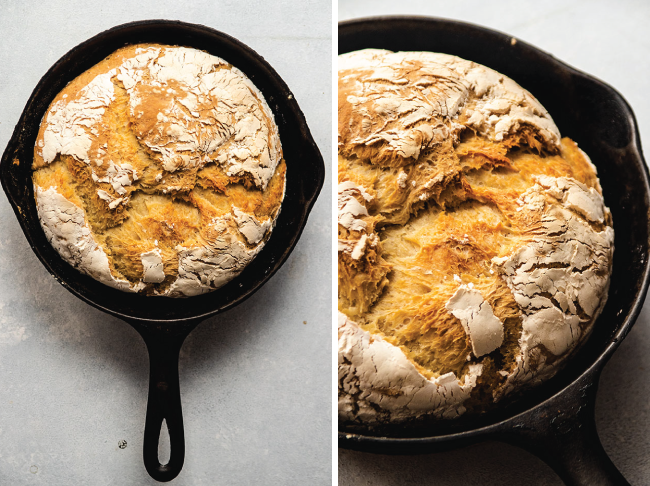
How to Bake Crusty Bread Without a Dutch Oven
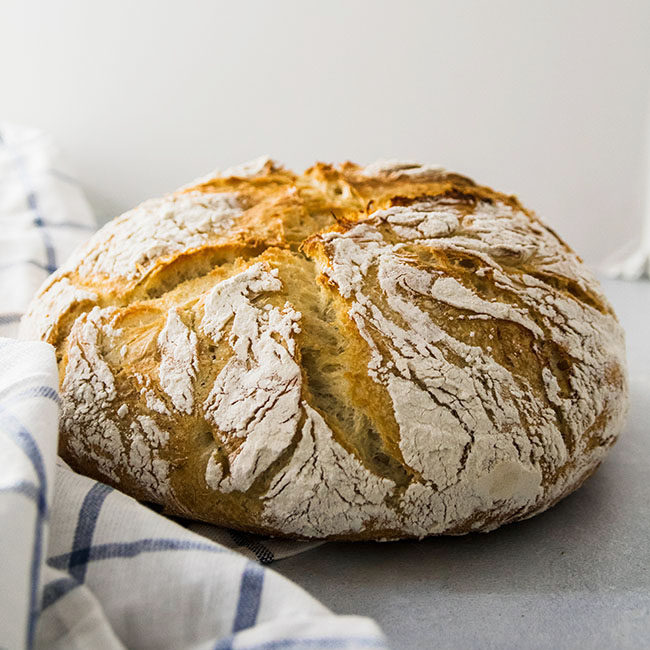
Roasted Garlic and Rosemary Bread
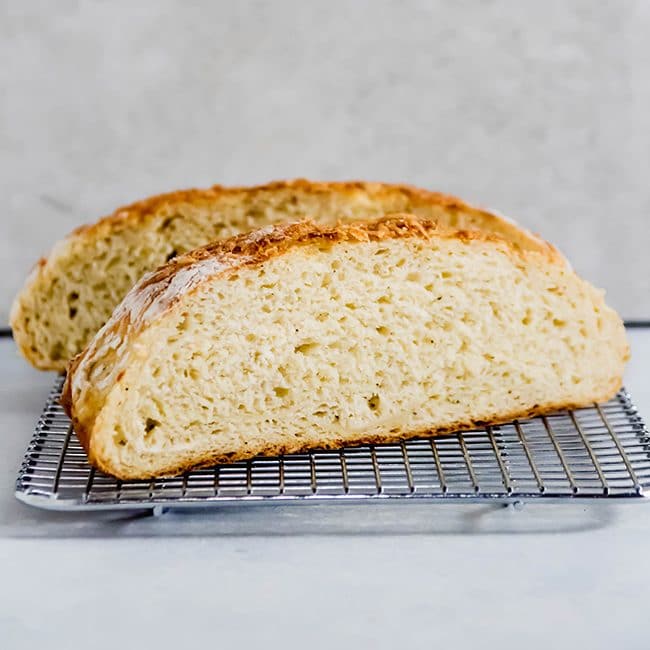
Easy Crusty Asiago Bread
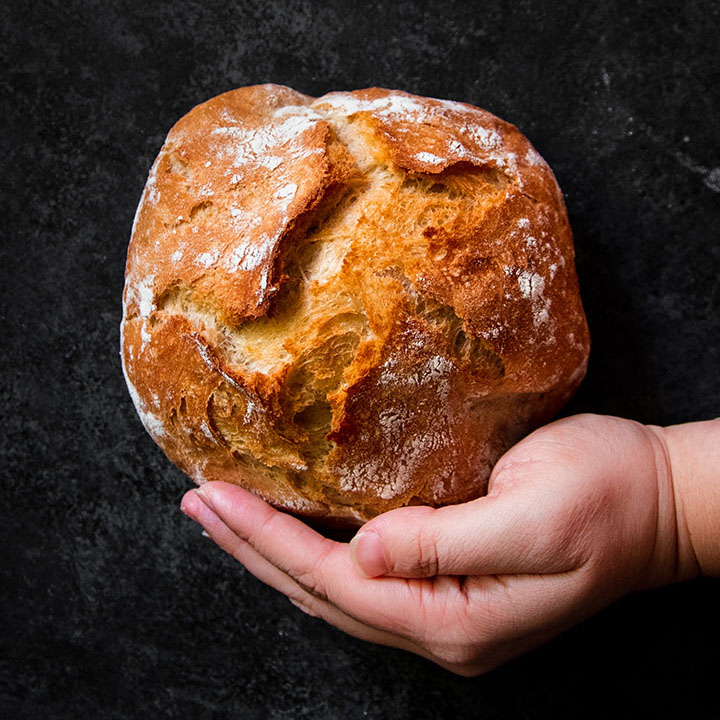
Small Batch Crusty Bread (Perfect for Two!)
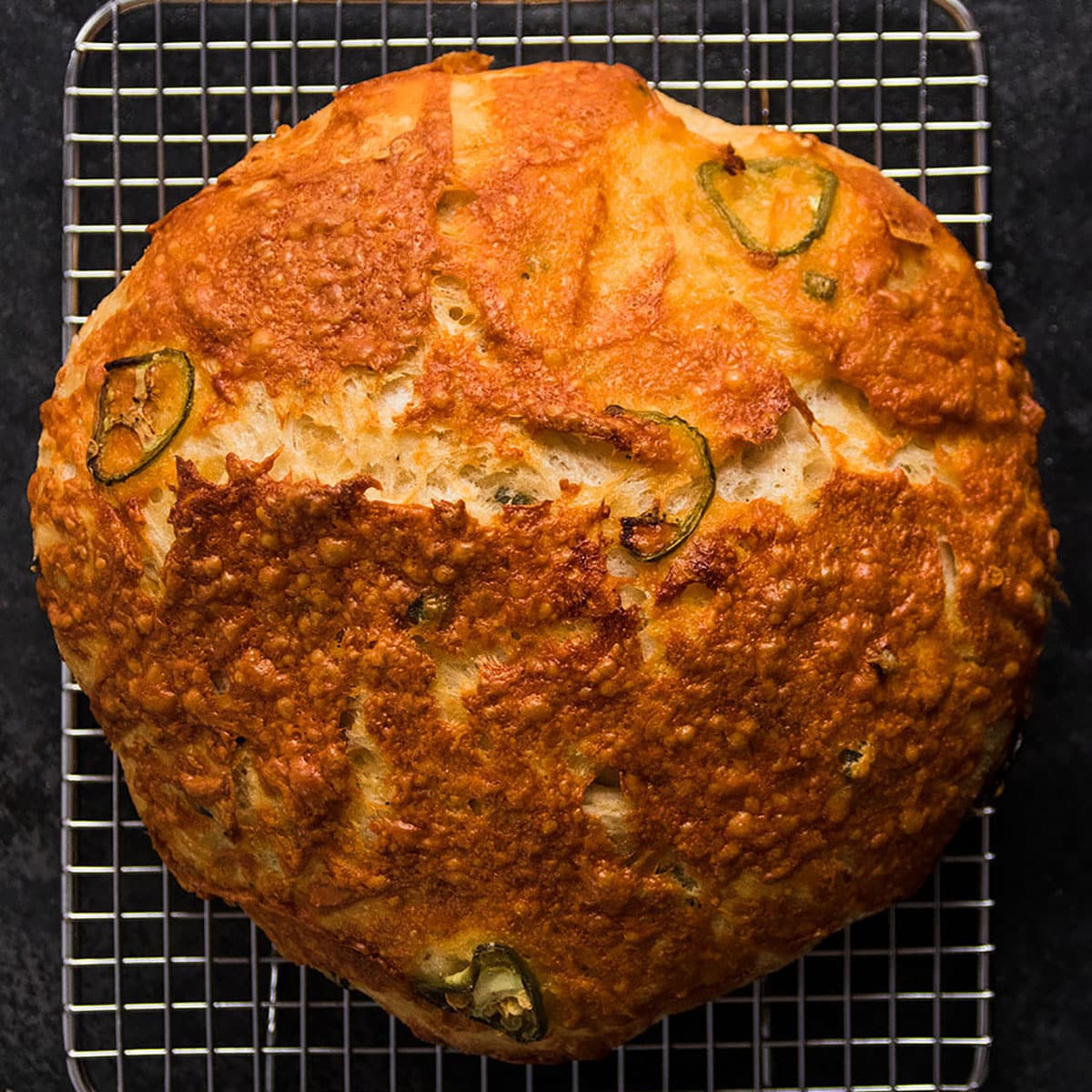
Jalapeño cheddar loaf
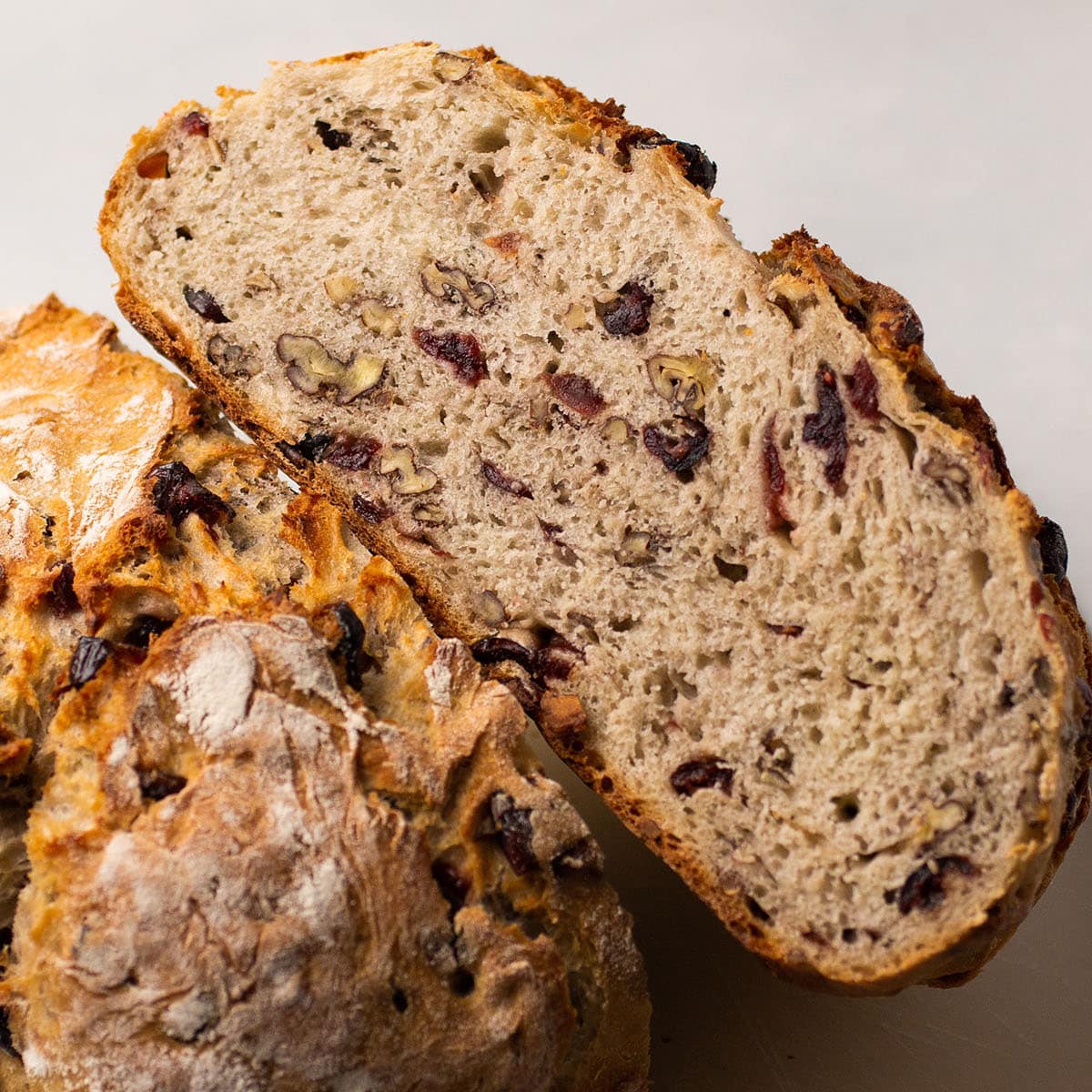


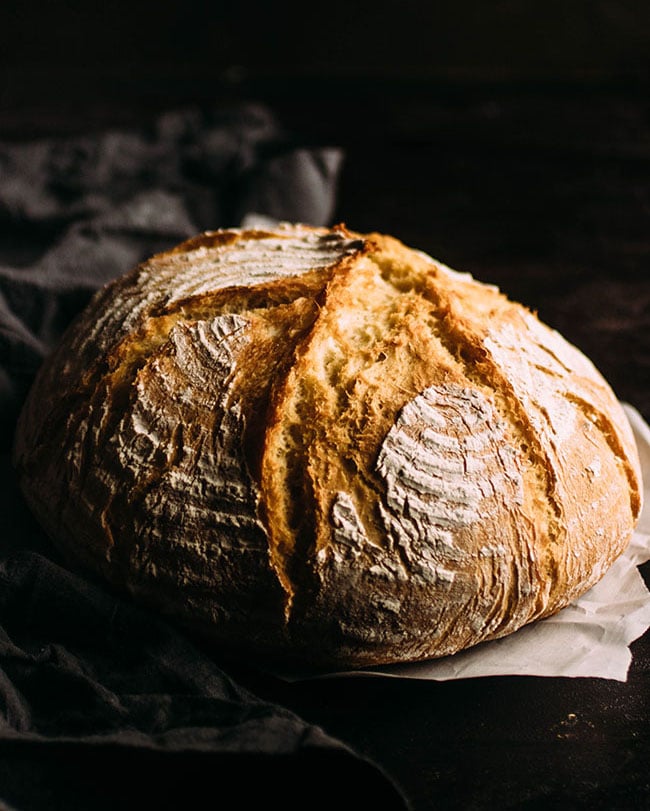
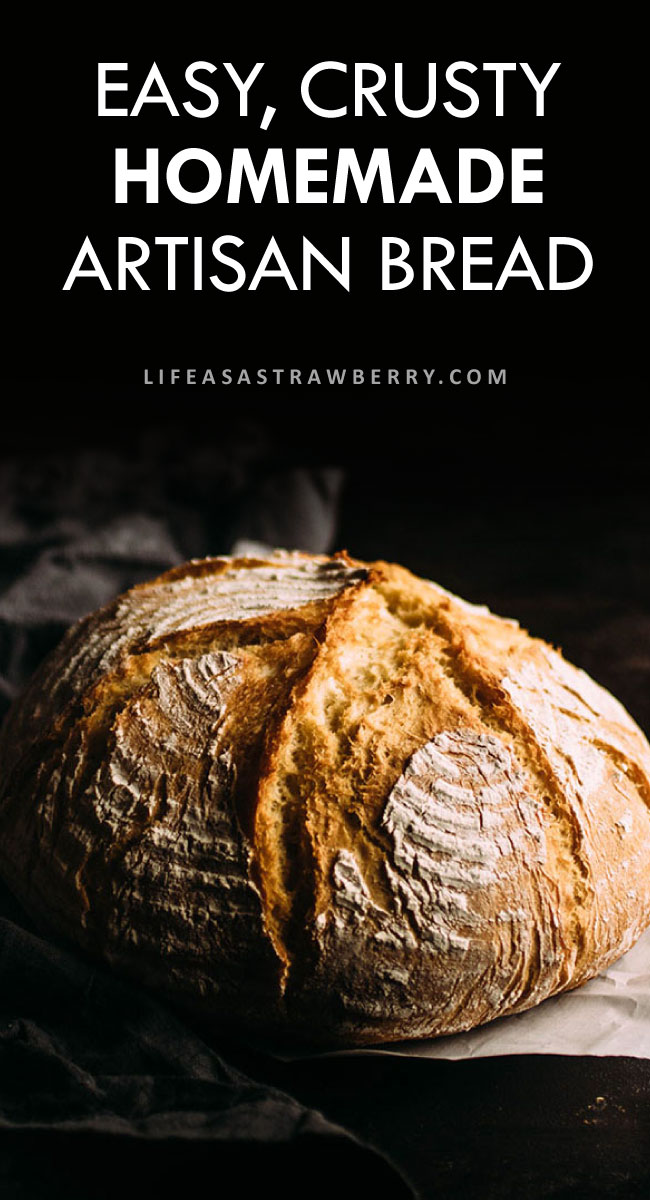
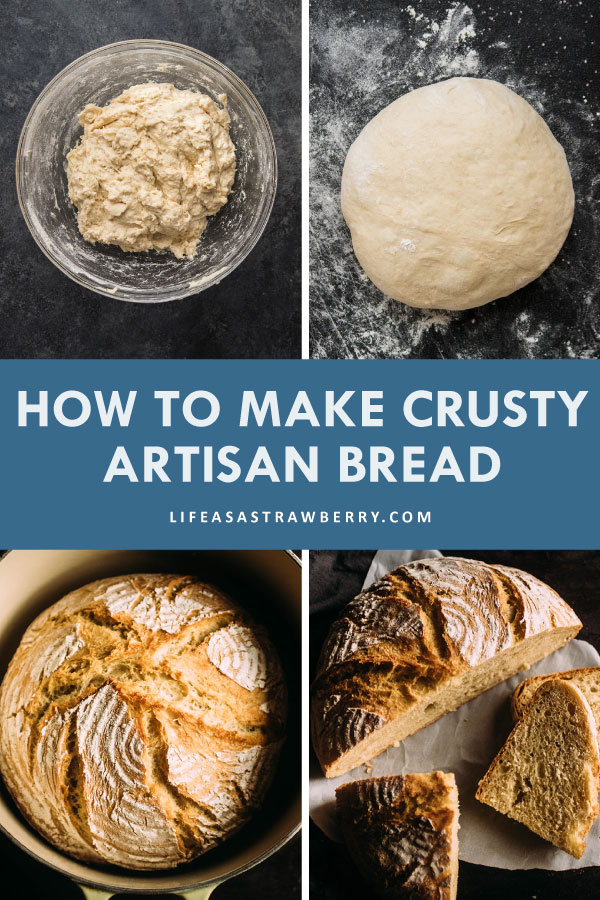

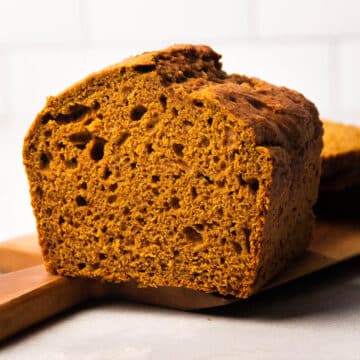
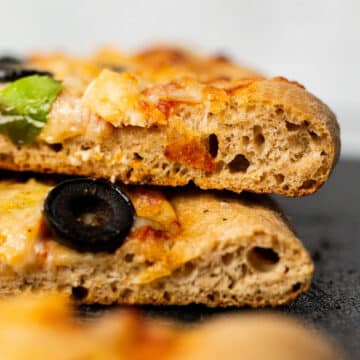
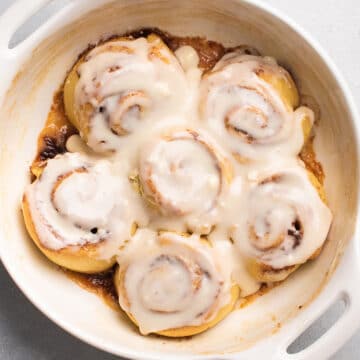
Dee Mittie
This bread recipe is my all-time 'go-to' for bread, I use it so often I keep the recipe on my taskbar! I've been making this bread for several years now and it has never let me down, even when trying out different additions like garlic parmesean, rosemary asiago, toasted sesame, all of them have been FANTASTIC! I was baking this bread about once a week for the longest time during the lockdowns and it freezes well so I could make extra in a pinch. You'd think I'd have the recipe memorized, and for the most part I do but I like keeping it on my taskbar in case I'm doing several other things at once...lol! I rarely comment on any particular recipe more than once but this one deserves a repeat recommendation, it's truly THAT GOOD! In fact, I'm making another loaf right now! It's fantastic toasted, making sandwiches with it, grilled cheese, garlic bread is amazing. I absolutely love this bread recipe and have shared it with many of my friends who have gotten the same wonderfully delcious results. This one is a family favorite and definitely a keeper! <3 🙂
Rhonda @ Life As A Strawberry
We love this bread too and agree it is great with everything; toast, garlic bread, sandwiches, the list goes on! We love your comments and reviews - thank you!
David
It was my first time making this bread and it came out fantastic. Very easy to make. I made it on my birthday, now I make one on everyone’s birthday. I renamed it The birthday bread. Everyone expects it now.
Rhonda @ Life As A Strawberry
I love calling it The Birthday Bread - you have some lucky friends!
Mishy
OMG! I normally make sourdough but it just got to the point where it was so time consuming. I still love sourdough but with a family I just don’t have the time to make a 24+ hour loaf. I am so so thankful that I came across this recipe! I started it in the morning and it was ready before lunchtime!! It was so easy that while I was making it I was skeptical that it would work. The bread came out delicious! You don’t have to be an experienced bread maker to make this successfully. Thanks!
Rhonda @ Life As A Strawberry
So glad you loved it! If you are interested in learning even more about bread baking we have an excellent online course with tons of information; videos, step-by-step instructions, additional bread baking techniques (including a large sourdough section), and more recipes. Here is the Everyday Artisan Bread Course link if you are interested in enrolling.
horia
I made the bread today with a mix of semi-white and 10% rye flour and it was absolutely delicious.
Rhonda @ Life As A Strawberry
A great combination! Glad you liked it!
Sarah
came out perfectly which breads don't always for me. it has the really thick crust i was hoping for. it was super easy to make and came together perfectly
Rhonda @ Life As A Strawberry
So glad this was what you were looking for!
Grace
I made this bread and it makes the house smell divine. It's delicious and really does live up to it's name easy and crusty. I don't have a dutch oven but made it in a covered corningware dish.Thank you so much for sharing this recipe!
Rhonda @ Life As A Strawberry
So glad you loved it. Good substitution with the covered corningware dish! We also have a post about how to bake this bread without a dutch oven if you are interested in other options.
George D
Dough is so wet. Wasted so much dough stuck to everything. Terrible.
Rhonda @ Life As A Strawberry
Oh no! We find this usually happens when ingredients are measured by volume instead of using a scale. Too much water, not enough flour and it can end up a very slack dough - which is not necessarily a bad thing - just a different hydration! Learning to recognize how dough should feel and look AND how to work with different hydration doughs is important when baking bread. We do cover different hydration levels and how to work with slack doughs in our Everyday Artisan Bread online course if you want to learn more about this. I hope you keep baking bread!
Henna A.
Has anyone tried this recipe with (any) gluten free flour?
Rhonda @ Life As A Strawberry
We have not tested this recipe with gluten free flour yet.
Marie
I've used this recipe in the past and love it! Next week I want to make it for a dinner, but will need to prep dough in advance since I'll be gone all day. I read your tip about proofing in the fridge overnight -- I'm wondering if I did that and set it out on the counter in the morning, would it overproof in the 8 hours I'm at work? How long does it typically take to come to room temp?
Thanks!
Jessie
I'm so happy you like the bread! With an overnight rise in the fridge, it usually takes 2-3 hours max for your dough to come back to temperature; unfortunately 8 hours on the counter would probably be a little too long for this recipe. If you're a member of our Everyday Artisan Bread online course, though, I'd recommend using one of our all-day bread recipes for your dinner! Those recipes are exclusive to EAB and are specifically designed to rise over a long period of time while you're at work. (If you're not in the course already, you can find it at everydayartisanbread.com!) This bread also keeps pretty well on the counter once it's baked: If you want to use this recipe but need to do the bulk of the work the day before, I'd recommend making and baking the bread as directed, but taking it out of the oven when you take the lid off (instead of letting it bake another few minutes to darken the crust after you remove the lid). The bread will be a little lighter but should still be "done" (to double-check, you can tap on the bottom of the loaf with your knuckles - it should sound hollow when bread is fully baked!) Let it cool and leave it on a wire rack on the counter (uncovered) for up to 24 hours, then just pop it back in the oven to heat up before dinner!
Kathleen
Love this recipe. I have made it 3 times and it is delicious one question, this last time my parchment paper burnt and stuck to the bottom of the bread. The Botton of the bread was darker than I would like. Am I cooking it too long or too high? I do use a Dutch oven. Thanks!!
Rhonda @ Life As A Strawberry
So glad you love the bread recipe! Sometimes our ovens can get out of temp a little. Use an oven thermometer to make sure your oven is still the temperature you expect. A baking steel may also help keep the heat more evenly distributed in the oven. If you don't have a baking steel, try placing your dutch oven on a heavy duty cookie sheet. If the bottom of the bread is still too dark, you can decrease the temperature of the oven by 5-10 degrees.
Mel
Delightful and easy recipe. Thank you so much for the very detailed instruction and video, helps us less familiar folks come out with success! I did screw up and put the temp at 360 not 460 and while it wasn’t as crusty/brown, still tasted great and turned out fine. I’ll do it better next go around 😀
Rhonda @ Life As A Strawberry
So glad this worked for you. Baking at a lower temperature still works great, as you found, it just makes a softer crust. We discuss the impact of all the different variables in our Everyday Artisan Bread Course if you are interested more in the science behind the amazingness of bread baking. It contains a ton of videos and step-by-step detailed instructions to help you in your bread journey. Happy baking!
Casey
What should I do if my oven doesn’t get to 460°? The highest it will go was 450°. Do I just cook it for longer?
Rhonda @ Life As A Strawberry
450°F will work just fine. Still remove the lid at the 30 minute mark. Then keep an eye on the bread until the crust is the golden brown you like.
Madelaine
This was my first time ever making bread and it turned out amazing!!
The only thing I did differently was that I scored the dough before I put it in the oven. Even after shaping the dough I felt that I didn’t have a noticeable enough seam so I scored it so the top would be nice and textured—it turned out amazing, it was the perfect rustic look that I was going for.
Will definitely be making this again, and super excited to try out some more bread recipes on the site!
Rhonda @ Life As A Strawberry
Congratulations on your first loaf of bread - so glad you loved it!
Cathy Ann Young
so awesome. Definitely a keeper.
Rhonda @ Life As A Strawberry
So glad you love it!
J Shepard
I've had a hard time making bread in he past, not with this one! Love it and have made it several times. Working on a loaf right now. Thank you for the recipe.
Rhonda
So glad you love it - Happy baking!
Misha
Amazing recipe - so easy and fuss free! I’m so glad I gave it a try because it usually doesn’t turn out for me. It was a hit. I just have one question… can I freeze the dough? If so, at what point does it go in the freezer and what steps to follow when it comes back to room temperature?
Thank you!
Rhonda
We are so glad this was a hit! We don't recommend freezing the bread dough. However, the baked bread freezes great. Bake the bread as directed and then freeze whole or in slices. Here is a good article on freezing bread dough.